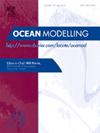Effectiveness of the Offline Fennel model for biogeochemical simulations in the Mediterranean Sea
IF 2.9
3区 地球科学
Q2 METEOROLOGY & ATMOSPHERIC SCIENCES
引用次数: 0
Abstract
Modeling the distribution of biogeochemical components in the ocean is essential for further understanding climate change impacts and assess the functioning of marine ecosystems. This requires robust and efficient physical-biological simulations of coupled ocean-ecosystem models, which are often hindered by limited data availability and computational resources. The option of running biological tracer fields offline, independently from the physical ocean simulation, is appealing due to increased computational efficiency. Here, we present an assessment and implementation of an offline biogeochemical model — the Offline Fennel model — within the Regional Ocean Modeling System (ROMS). Our methodology employs ROMS hydrodynamic outputs to run the biogeochemical model offline. This work also includes the first ground-truthing exercise of the referred offline biogeochemical model. We use a variety of skill metrics to compare the simulated surface chlorophyll to an ocean color dataset (Copernicus Marine Service Mediterranean Ocean Color) and BGC-Argo floats for the 2015–2020 period. The model is able to reproduce the temporal and spatial structures of the main chlorophyll fluctuation patterns in the study area, the Northwestern Mediterranean Sea. This area is of particular interest as it is one of the most productive regions in the entire Mediterranean Basin, with open-ocean upwellings and deep winter convection events occurring seasonally. The typical behavior of the region is likewise effectively represented in the implementation, including offshore primary production, nutrient supplies from the Rhone and Ebro rivers, and mesoscale hydrographic structures. This study provides a baseline for ROMS users in need of executing more biogeochemical simulations independently from more computationally demanding physical simulations.
离线Fennel模型在地中海生物地球化学模拟中的有效性
模拟海洋中生物地球化学成分的分布对于进一步了解气候变化的影响和评估海洋生态系统的功能至关重要。这需要对耦合的海洋生态系统模型进行强大而有效的物理-生物模拟,而这往往受到有限的数据可用性和计算资源的阻碍。离线运行生物示踪剂场,独立于物理海洋模拟,由于提高了计算效率,因此具有吸引力。在这里,我们提出了一个离线生物地球化学模型的评估和实现-离线Fennel模型-在区域海洋模拟系统(ROMS)。我们的方法采用ROMS流体动力学输出来离线运行生物地球化学模型。这项工作还包括参考的离线生物地球化学模型的第一次地面实况练习。我们使用各种技能指标将模拟的表面叶绿素与海洋颜色数据集(哥白尼海洋服务地中海海洋颜色)和BGC-Argo浮标在2015-2020年期间进行比较。该模型能够再现研究区西北地中海主要叶绿素波动模式的时空结构。这一地区特别令人感兴趣,因为它是整个地中海盆地中最具生产力的地区之一,开放的海洋上升流和冬季深层对流事件季节性地发生。该地区的典型行为同样有效地体现在实施中,包括海上初级生产、罗纳河和埃布罗河的营养供应以及中尺度水文结构。这项研究为需要执行更多生物地球化学模拟的ROMS用户提供了一个基线,这些模拟独立于计算要求更高的物理模拟。
本文章由计算机程序翻译,如有差异,请以英文原文为准。
求助全文
约1分钟内获得全文
求助全文
来源期刊

Ocean Modelling
地学-海洋学
CiteScore
5.50
自引率
9.40%
发文量
86
审稿时长
19.6 weeks
期刊介绍:
The main objective of Ocean Modelling is to provide rapid communication between those interested in ocean modelling, whether through direct observation, or through analytical, numerical or laboratory models, and including interactions between physical and biogeochemical or biological phenomena. Because of the intimate links between ocean and atmosphere, involvement of scientists interested in influences of either medium on the other is welcome. The journal has a wide scope and includes ocean-atmosphere interaction in various forms as well as pure ocean results. In addition to primary peer-reviewed papers, the journal provides review papers, preliminary communications, and discussions.
 求助内容:
求助内容: 应助结果提醒方式:
应助结果提醒方式:


